Since starting development on the Electric Zine Maker I’ve been hoarding links to interesting, unusual, strange, small, or just cute tools.
This has grown to be a strong area of interest as I’ve been diving into what even makes a tool approachable… How much experimental UI or humor is too much? Do people even want tools that are goofy? What else is out there from creators making small and interesting tools that solve a variety of creative problems?
Before I begin, you should definitely go check out Galaxy Kate’s work on Casual Creators. She has done A LOT of work in this field, and should be considered a go-to resource for this. I haven’t dug into everything from her, but that’s seriously the best place to start.
When I was already well into development of the Electric Zine Maker someone pointed me to this document from her, and it was 100%. Especially the segment where she talks about the “blank canvas” issue (in which people have a hard time with being presented with something “empty”).
These are all things that I find myself tackling while building a tool that I’m trying to make as approachable and fun as possible, AND while still maintaining its experimental qualities (without chasing people away because it’s “too weird”).
All that said, designing an art tool that breaks away from our standard ideal of what an art tool should be (software that surrounds maximizing productivity and output), and going in the direction of it being different, with different intentions, can present you with a lot of interesting problems to solve.
It’s so much like designing a game, especially if you view what you’re making as an “art toy”… I don’t know why we keep the two apart when we talk about them. A lot of the design challenges between the two are similar.
My own exploration of this space has leaned heavily into trying to understand what made old edutainment software so special to people. When we talk about tools that are different, many of these examples come up. For example, Kid Pix keeps being mentioned when describing the Electric Zine Maker.
I don’t think it’s so much about nostalgia. I think a lot of this has to do with…
1) The tools were fun, goofy, lighthearted environments.
2) They were simple. The things done in them were kept simple. This made the creative environment less overwhelming, and more approachable.
3) The lack of professional “polish” to these tools made it less intimidating to make things in. If the tool looks “amateurish” then it’s OK to be amateurish in it too! (this is probably the controversial point tho)
Consider older creativity focused edutainment software that we so fondly look back on… In my UI post I mentioned a few examples, but here are a couple more that I think are interesting to pick apart for the unconventional TYPE of creation they are enabling, and for how approachable they were at it…
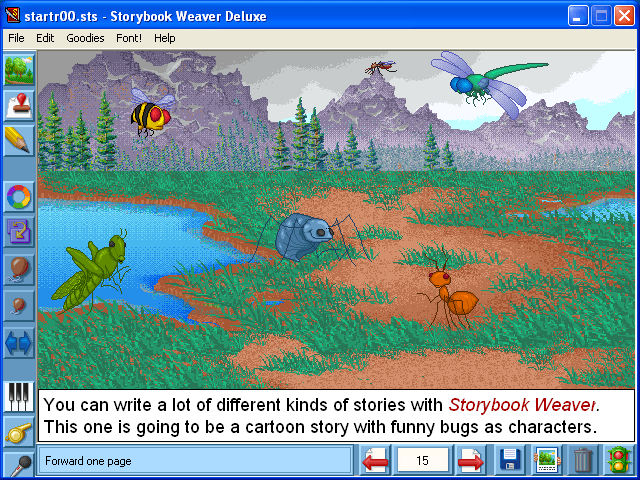
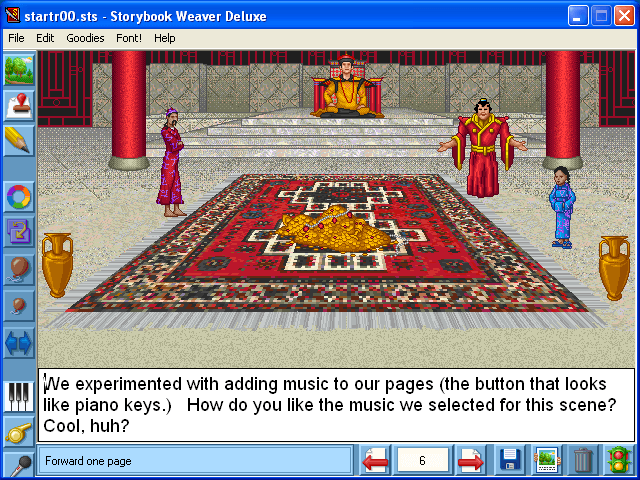
Storybook Weaver Deluxe (read the Wiki on it here) was a program that enabled you to make small stories. It offered something like a “canvas” on which you could drag and drop characters and backgrounds (there were hundreds of these), and then you could write a story for the scene you made.
There were lots of effects too that made creating things in it really cute.
I think this is an interesting example because it encouraged creative writing. Coming up with stories can be hard. The presence of lots of environments and characters to chose from, and these you could make your own in a fictional setting, helped encourage that.
It’s also unconventional because what you make in it doesn’t exactly fit any practical application. It’s very focused on creating story books.
Something that leaves a similar impression is Library of Babble. A game that gives you a beautiful surrealist environment to explore, in which you can leave behind small pieces of writing for others to find.
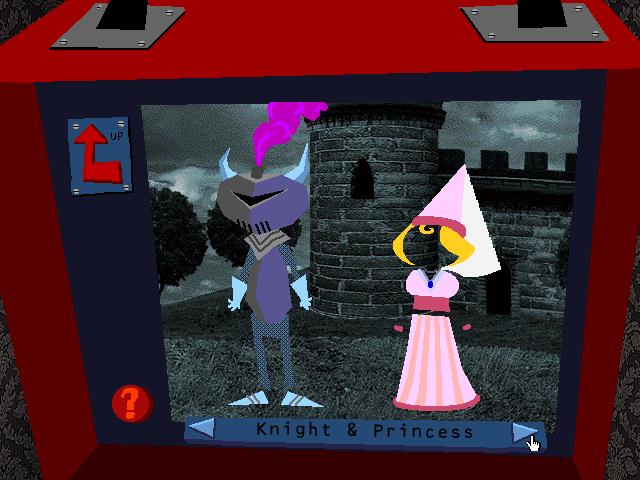
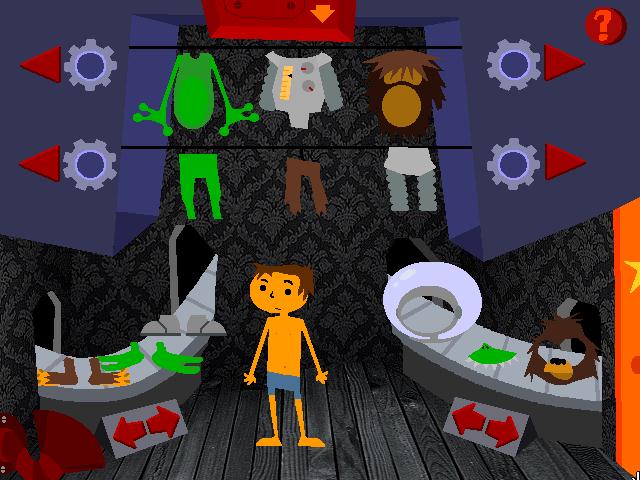
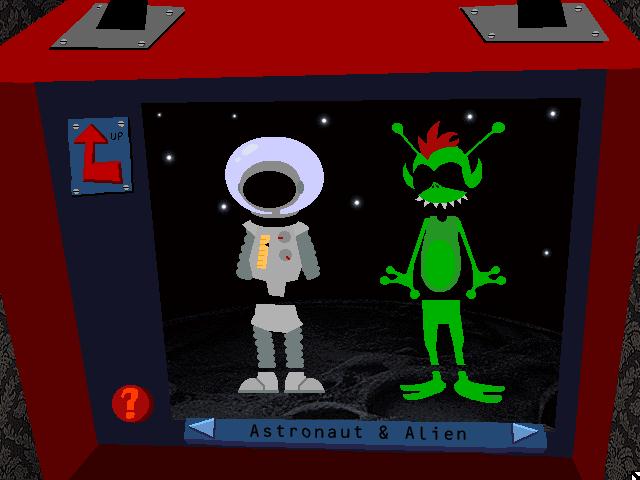
Elroy’s Costume Closet was a game about dressing up and theater. I played the shit out of this back when, so I paraphrase this strongly and recall my description from memory (sorry for inaccuracies)…
The game allowed for a lot of creative goofing around. It was pretty amazing. As far as I remember, you could make your own costumes too? Things were animated, and it really felt like you were putting together something with living cartoon characters that acknowledged your role in participating. It was a lot of fun for how silly it was.
At one point the company that made it ran a costume creation competition. Myself, my sister, and my brother, all decided to enter. I wrote a story about mining the moon for cheese and submitted it under my brother’s name.
Two of our entries ended up on the website along with a ton of work from other kids. It was the cutest thing ever… So I have fond memories of creating things in this game-toy-tool.
Analytically tho, I think Elroy’s Costume Closet is an interesting example for how what you make in it is basically “useless” in terms of real world value (or application)…but the way it set itself up encouraged you to really get into it and make beautiful things.
In case these examples are too dated (Costume Closet and Storybook Weaver aside), a more current example to illustrate this would be FlowScape. A beautiful game-toy that lets you “paint with nature” and create these stunning scenes.
The intention of this is to make beautiful landscapes. As a tool, FlowScape is not so much about “solving a problem” or “filling a need”…it’s something new for you to find your own purpose for.
So I think toy-like-tools like these are really important. I think it’s sad that creativity is relegated to having to have “real world productive value” in order to be considered valuable.
It’s not a waste of time to just go off an do something completely useless, be bad at it, and be proud of what you made in it. Toy-tools like this disarm creative ideologies that keep the value of our creativity too rooted in what capitalism deems important (it must make money and be practical!)
Making tools that are silly, sweet, pointless, and offer some strange creative task, are important in helping un-internalize a lot of that. I think if these things were more normal “writers block” or “creative block” wouldn’t be such a big problem. We’re way too judgmental about ourselves, as artists, because our work has this “urgency of value” looming over us.
It’s good creative therapy! (Note: See the success of Kai’s Power Goo as further proof of this)
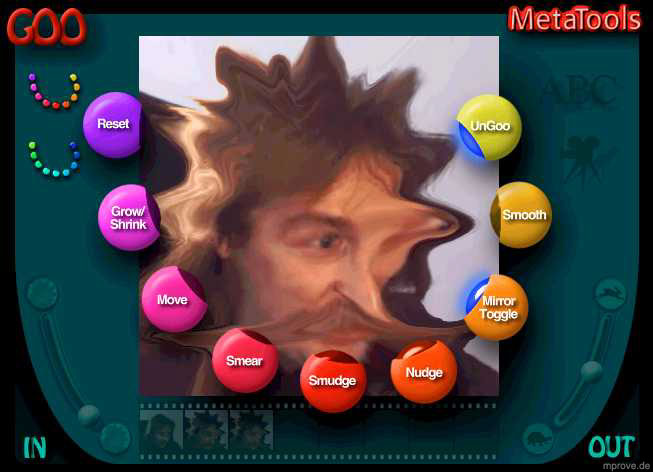
SO I think what makes art tools (creative toys) interesting is simplicity and restrictions.
Setting the mood with the UI, and making a fun silly environment is a big part of this, but I noticed that things which offer very focused restriction end up being the most fun to people. The larger a tool gets, the more intimidating it seems to become.
Consider tools like Pico-8, Twine, or Bitsy (which I will talk about more later).
I think these end up being so successful because they’re both cute and neatly restrictive.
When you engage with these tools, the initial feeling is less about being overwhelmed by a high-powered professional environment with lots of features (“Oh, god what should I make in this?? I’m not good enough at this!”) and more about just tinkering.
In an older post I mentioned that it’s not fun to draw dicks in Photoshop because Photoshop is a professional tool, so the dicks you draw in Photoshop better be REALLY good (no pressure!) otherwise you have failed Photoshop… so this necessitates making tools in which drawing dicks IS actually fun.
These smaller cuter tools offer kind of the creative option of that.
They’re not judgmental, and it’s perfectly OK to just be dumb in them.
When you look where these “big” creative tools originated, you will see how simple they used to be. I think it’s exactly that simplicity that is the reason people initially fall in love with them.
For this, I’m looking a lot at Future Splash. It’s where Flash came from…
I used to use Future Splash. I well remember the evolution this tool went through, so it’s an interesting example to me.
You can see a clear line being drawn from this “appealing to everyone”, to this becoming more and more intimidating to new comers (and therefore loosing that type of audience).
It went from a cute, new, exciting idea, to a professional environment for building complex things.
I think you can see that happening with tools like Unity as well.
It’s REALLY hard to balance growth, new features, with bloat and losing approachability.
Approachability being the important word in this conversation…
So, ok, this was a very long introduction summarizing a lot of my thoughts lately.
The goal of this post is to highlight a ton of tools that I’ve been hoarding, and would like to draw attention to for how amazing they are.
All of these are very interesting to pick apart, and understand… aside from just creating in them.
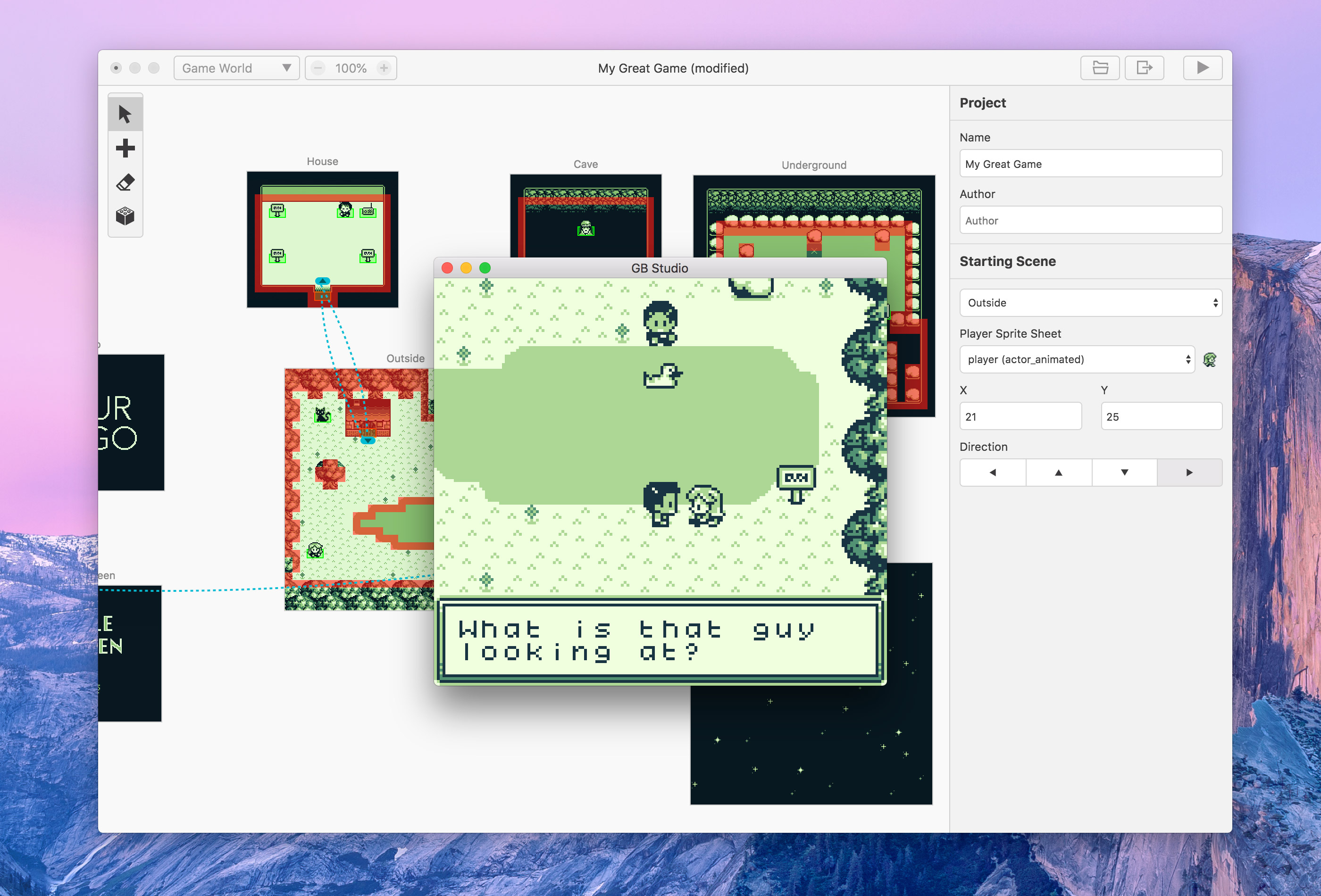
* https://chrismaltby.itch.io/gb-studio
My current favorite is GB Studio. When I found this, I was blown away by it.
GB Studio is a tool for making Game Boy games. You can run these on any emulator, or you can run them on your Game Boy if you have a flash cart!
This is amazing to me. If you grew up with a Game Boy, I think it’s anyone’s dream to try to make a game for it at some point.
Whenever I tried, it seemed like a really complex, unattainable thing to do… like you need to know Assembly and all sorts of hardware stuff. I never really had time to get into it.
GB Studio is amazing for how it simplifies this very complex, very mystical thing.
If you boot it up, the interface is really simple. It’s very drag & drop, with friendly examples. It’s not hard. It’s welcoming.
GB Studio could easily afford to be much more scary, and intimidating, but it’s such a wonderful example of making something approachable.
It’s open source too!
@maltby did a good service to society by making this! :)
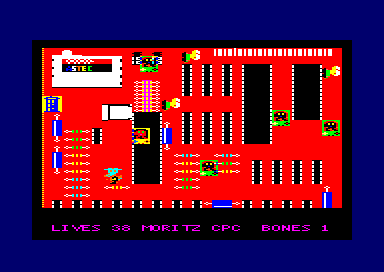
* https://jonathan-cauldwell.itch.io/multi-platform-arcade-game-designer
Multi-Platform Arcade Game Designer is something in the same vein as GB Studio. It makes building retro games, for old formats, much more accessible.
It enables you to create games for 8-bit computers.
“Supported formats include the ZX Spectrum, Amstrad CPC, BBC Model B, Dragon 32/64 and Acorn Atom, with more on the way. Create blocks, sprites and screens, knock out a few lines of code in AGD’s simple scripting language (inspired by BASIC) or get the tool to create the code for you and create an 8-bit game that would have graced any software house’s catalogue back in the day.”
I love both of these examples (GB Studio and MPAGD) for the way they place these formats within reach of anyone. It’s amazing, and the kind of thing that keeps “the dream alive” when it comes to these retro platforms.
Of course I would be remiss if I didn’t mention Adventuron Classroom.
A tool designed to teach kids to code. It lets you design and build old-school text adventure games. This isn’t just for kids. It’s very accessible to anyone.
I think this is a wonderful thing, and kind of reminds me of Twine.
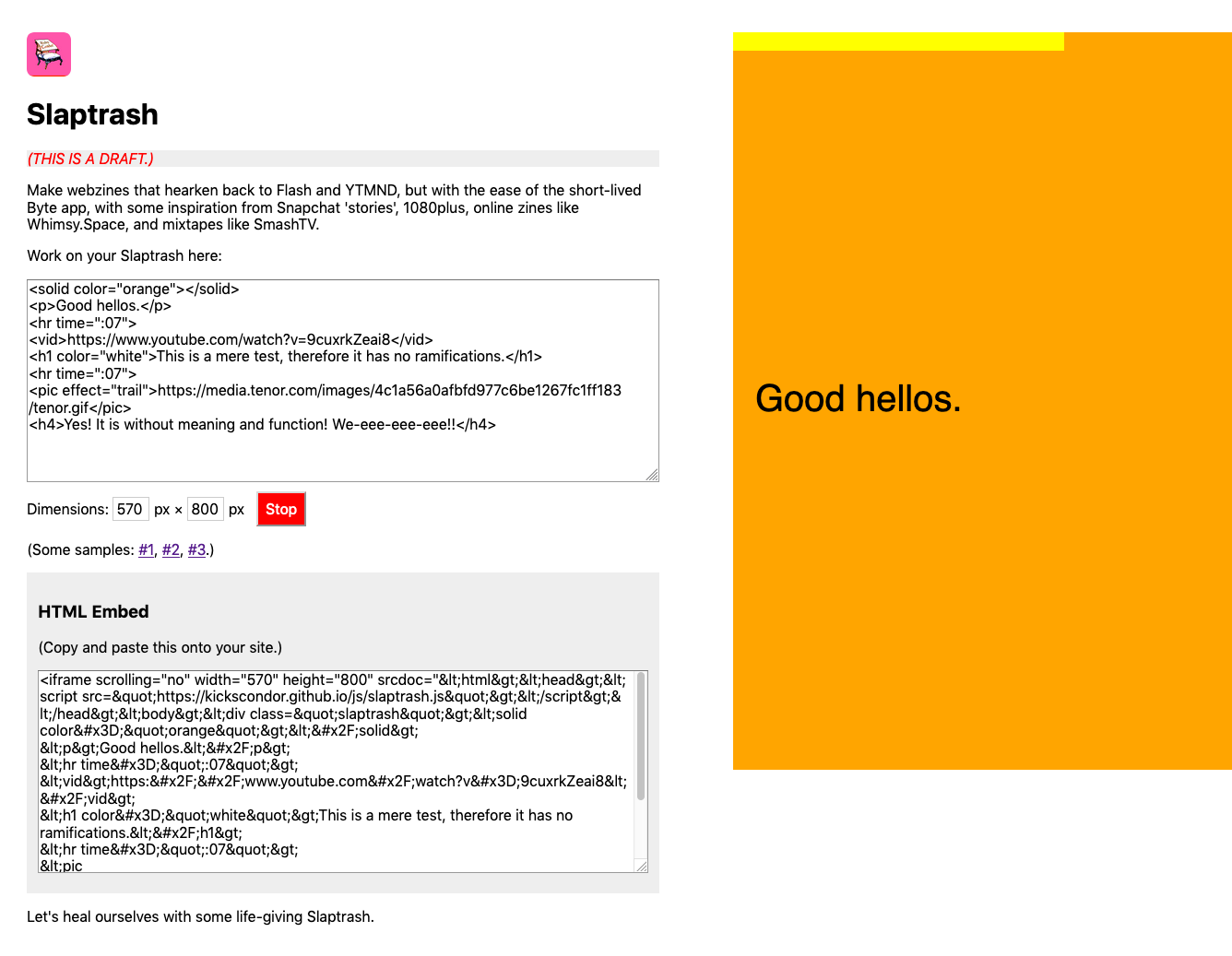
* https://www.kickscondor.com/slaptrash/
Slaptrash is something that I found really affirming when making the Electric Zine Maker. I was introduced to it later, and it really gave me a lot to think about.
I think this thing is amazing, and incredibly relevant when discussing the space between tools and toys.
Slaptrash is a browser based webzine maker. It hearkens back to the days of Flash and YTMND. You’re given a bunch of HTML tags, image support (animated gifs!), video (youtube!), audio, cards, and tiles…
The highlight of this is the text-to-speech support. Robots will narrate what you’re saying in that classic demented robot tone associated with TTS. Writing in it can get pretty hilarious.
You can compile your creation and then embed it in an iFrame (to copy and paste onto your own site).
This is very much of a meme-maker.
It kind of surprises me that not more people know about it. At the same time I think if personal websites were more of “a thing” again, then projects like this would do better.
The web has changed a lot (social media is the main space that we exist on, not so much forums, personal websites, or spaces for personalized expression…). I feel like Slaptrash is a strong nod to the dream of what the internet used to be, and keeping that dream alive.
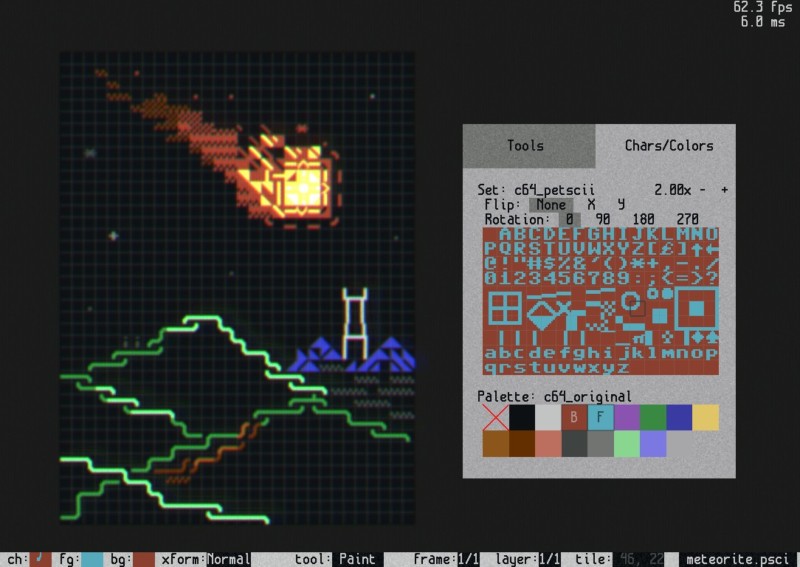
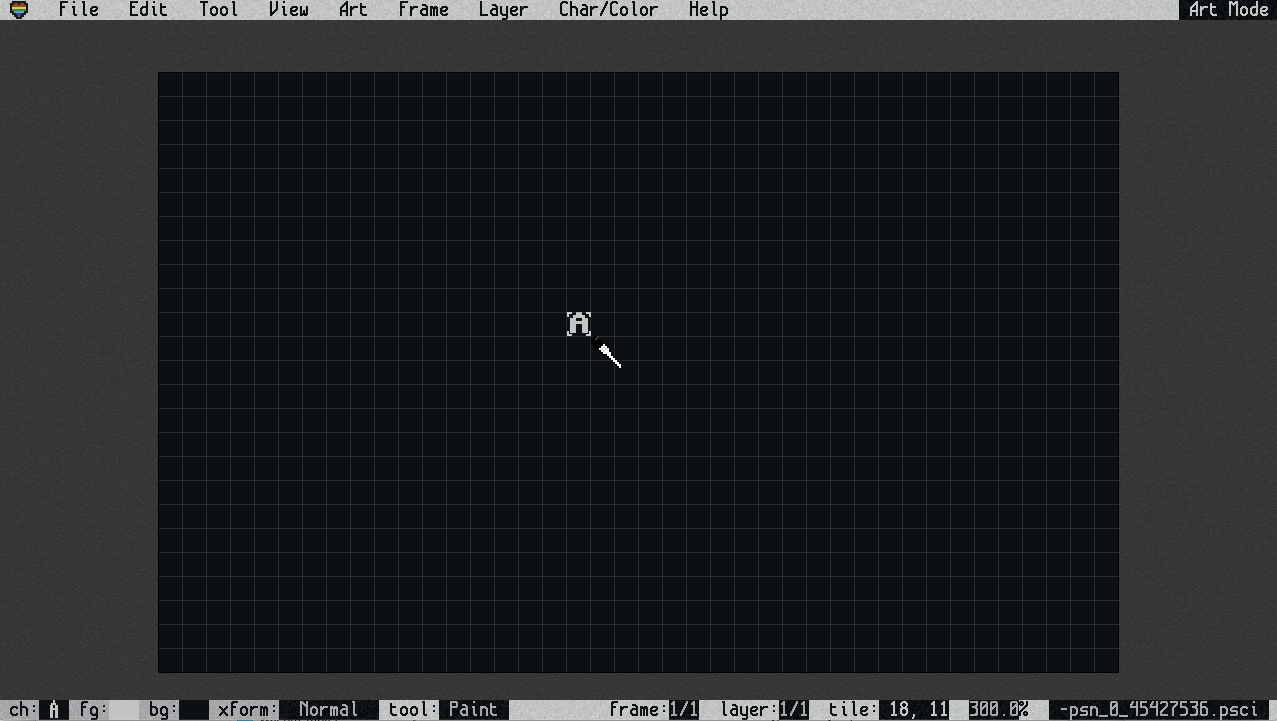
* https://jp.itch.io/playscii
Playscii is a beautiful approachable ASCII art creation tool. I file this more under “experimental” art software for how it completely takes on the theme, and even looks unique. The UI work is beautiful.
You paint ASCII art, select characters to paint with, select colors… there’s a grid to paint over… because of the UI design, working in it feels “techy”. It’s a fun feeling to have when making ASCII art.
It’s another wonderful example of taking something that is a tedious time sink (making ASCII art with a keyboard), and giving you a tool that makes this accessible.
You can export as plain text, and animated gifs too.
Over the years I’ve tried making my own ASCII art programs (for example, this silly browser based one). An ASCII tool is probably something any developer has done… I mean, come on. It’s ASCII!
In my opinion, Playscii is the best one.
It’s the most serious take on this, and the most thought through.
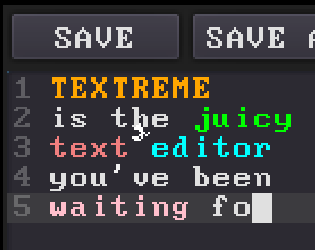
So far all these examples have been more serious, or exploring themes on a more sincere level.
I think a special mention should be made for tools that parody tools. Like things that exist kind of as a software parody.
* https://le-von.itch.io/textreme
Textreme is a really interesting thing to look at.
It’s basically a juicy text processor. You can write text with effects, and explosions, and it’s kind of like a typewriter with TNT. Writing in it is hilarious.
Textreme is kind of the thing that’s totally up my alley! I love everything happening here.
In the past I’ve made parody software about virtual desktop assistants (Electric Love Potato), virus scanners (Electric File Monitor), and even a joke media player for music, (Electric Love Potato Playlist Player). The later of which lets you drag and drop your audio files (.mp3, .wav…) onto a desktop potato and the potato assembles a playlist. The potato then plays your music, while commenting on your musical tastes, and constantly interrupting the music with comments about how much it likes or dislikes a song.
Things like Textreme fill the void that software doesn’t have to be serious. Software can be silly. The desktop shouldn’t be such a boring, productive, uptight space.
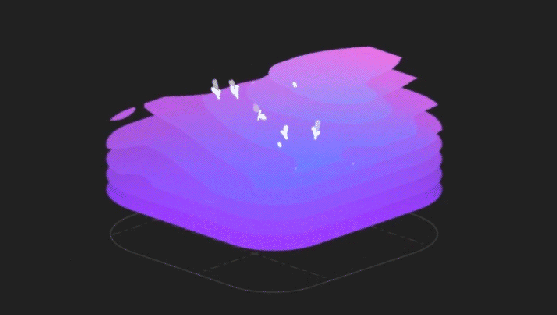
Most of what I’ve mentioned has been very tool-like, but I think there’s also an interesting space in games where the game itself is more about creativity. Games that blur the line between “is it a tool? is it a toy? is it a game?” where the point of the game is to explore making something, either very fictionally and abstract, or more literal.
Three games that I think are very interesting examples about exploring creating something in a fictional environment are Library of Babble, Mendel and ART SQOOL.
I think it’s important to bring these up because this is where we start to lose the distinction of what an art tool really is anymore. I mentioned that designing one is so much like designing a game, I don’t know why we even keep the two apart.
Library of Babble gives you this stunning abstract “landscape” to drift through. Tiny notes, thoughts, poems… from other people fade in and out as you explore. You can leave your own writing behind for others to find. The experience is an accumulation of thoughts from anyone that has played it. I love it for how it “inspires” a type of moody writing in you, while allowing you to be part of that world in such a creative way.
Mendel I mention here because, to me, it’s very relevant to “nonproductive creativity”. Playing it is like popping bubble wrap. It’s both about exploring, but also creating.
In Mendel you are put on an island, and have to plant things. You cross breed, and try to explore new varieties by taking from one plant and merging it with another. You can easily get stuck in it for a very long time, trying to get a plant to grow a certain way. I think this is very interesting because you’re creatively participating in forming an environment, while having to work within (or against) its rules.
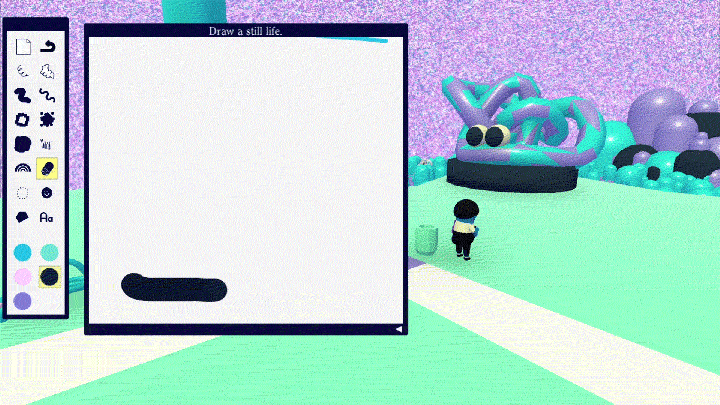
* ART SQOOL is a hilarious sweet indie game about being at art school. It’s silly for how strange it is. I laughed a lot while playing it. You are tasked to draw something, usually the instructions are very vague and strange, and then you wander about this beautiful playdoh like world looking for something to inspire you. You have a bunch of weird art tools that you can use to draw the picture. Once you draw it, you submit it in for scrutiny. You are given some arbitrary grade, and either pass or have to go back to do the assignment again, if it wasn’t good enough for your weird strange professor. It’s a really interesting premise for a game that’s wrapped around an art tool. Playing it is creative, silly, but also appropriately frustrating (for when you fail your assignment). It’s a game that asks you to be creative, while also harshly judging your creativity, and it’s a very interesting experience for that.
Edit: Also completely in line with the above three examples, is Sok-stories, which I should have mentioned!
It’s a tiny, adorable, game maker for making cute stories. Making things in it feels more like a game than a tool, and I think this is a wonderful example of the convergence between the two.
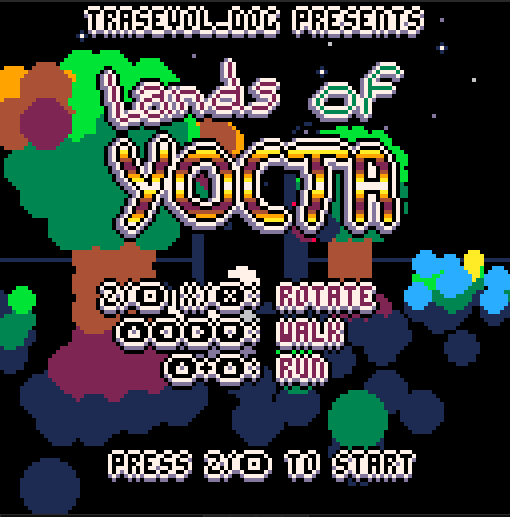
…Obviously this is getting long, and I could literally write a book about this at this point. I’m going to wrap up with some closing thoughts about designing these things, and then drop links to all the tools that I’ve hoarded.
The wonderful world of shareware tools from tiny indie teams is amazing, and I hope this sort of thing grows more. It helps a lot to have tools that balance out the monopolized silicon valley world of creating things on the desktop.
I think these small gems are interesting for the art styles they give you to work with.
Pico-8 and Bisy are both fascinating examples of this.
A tool’s design very much informs the work that you make in it. Each has an aesthetic that’s unique to it.
This is something I’ve grappled with a lot while building the Electric Zine Maker. I do want something that allows for all sorts of art styles. At the same time, my own personal preferences will strongly impact the art that it enables.
It’s really hard to make something that’s “generic” enough to fit other people’s art styles. The look and feel of what I personally prefer, as the developer, strongly influences the resulting art styles that come out of that tool. If I were to sacrifice the bright loud colors, or strange UI design, I think it would have a counterproductive effect on the tool. It would be less about casual creation, and more about “serious” art. The things (features) people expect from it would change too.
I don’t think there is necessarily the perfect “aesthetic agnostic art tool”. They will always come from a point of view, but I think that’s what makes them so interesting.
The way people master these tools, and even push that point of view further (breaking the tool if they must) is what’s special about art on computers.
The looks, aesthetics, art styles… we have on computers is a community effort. It’s an accumulation of platform and reaction to platform.
It’s a tool that made it possible, involving the personal preferences of the people that designed it, and then it was the community that took it, worked to exploring these possibilities, and even broke new ground with what gets done in it.
For example, see Lands of Yocta by Trasevol Dog. This person mastered Pico-8, and then decided to go completely against what the platform usually is, to explore something completely new with it. So you have this really unique 3D environment on Pico-8.
There are TONS of examples like this. This is how platforms constantly grow.
This is why the democracy of tech is so important. We all get to enjoy this type of collaboration, and collectively benefit from the new things coming up. Fuck monopolies trying to control that.

Ok… linkdump incoming…
https://lorenschmidt.itch.io/dungeon-decorator
“dungeon decorator is an easy to use, web based tool for making games!”
https://dacap.itch.io/aseprite
“Aseprite is a sprite editor that lets you create 2D animations for videogames.”
https://jeremyoduber.itch.io/js-zine
“A simple HTML5/JavaScript template for showing off your Electric Zine Maker zines on itch.io on the web and on mobile.”
https://sophieh.itch.io/sophies-dice
“Sophie’s Dice is a dice roller application that lets you roll many kinds of virtual dice, and make custom dice suited for almost any game.”
https://lyravr.itch.io/lyra
“Lyra is a playground for musicians to experiment in without real world limitations. Build fantastical music sequences with your bare hands, creating visual symphonies that you can fully immerse into.”
https://aarre.itch.io/huono-tv
“This is called HUONO TV, which is finnish and in english it means bad tv. This is a video playing software, where you put your video files into a folder and it plays them inside the bad tv in the 80’s environment.”
https://pawbyte.itch.io/game-pencil-engine
“Game Pencil is a 2D video game creation tool. It was created from the ground up to create wonderful console, desktop and web games. ”
https://wano.itch.io/rpg-paper-maker
“Making 3D games is too complex? RPG Paper Maker will simplify your work!
RPG Paper Maker is a game making engine, free for non commercial use, allowing you to create a 3D universe with many 2D sprites and even 3D objects using a simple interface for all available platforms: Windows, Linux, and MacOS.”
https://the-local-group.itch.io/vnengine
“The 0m3ga Visual Novel Engine will play visual novels as well as let you create and share them. This visual novel creator will let you make your own visual novels without needing ANY programming skills!”
https://thaon.itch.io/mgm
“Create games easily and rapidly with the Micro Game Maker(MGM)!!!
If you’re just starting making video games or you are already a veteran, MGM is the tool for you.”
https://adambiser.itch.io/wdc
“WDC is a Windows editor for ID Software’s Wolfenstein 3D and Spear of Destiny games that contains everything you need to mod these retro gems!”
https://kasumi.itch.io/ichr
“Load an image or image sequence and get an NES ROM that displays your graphics! (GIFs aren’t supported yet, it must be a PNG sequence. Sorry about that!)
NES homebrew developers can use it to create bankswitched CHR for parallax effects or tile animation.”
https://antfs10.itch.io/brainfuck-designer
BrainF*ck Designer
“What is BrainFuck?
BrainFuck is a programming language consisting of 8 characters. All calculations are done in a 1 dimensional memory “tape”. Each cell able to hold a value from 0 to 255.”
https://briarsweetbriar.itch.io/the-affinity-engine
“The Affinity Engine is an open-source, browser-based game engine. It’s entirely free: no licensing, no royalties, and no price tag. And since it’s browser-based, its games are de facto cross-platform: PCs, Macs, iPhones, Androids, you name it. In fact, that lovely little greeting Ember and Diy just gave you is itself an Affinity Engine playing in your browser.”
https://blackgoku36.itch.io/paddy-editor
“Paddy-Editor is open-source cross-platform 2d game editor. It have in-build logic nodes editor(like blueprints in ue4) which you can use to describe game logic in.”
https://renpytom.itch.io/renpy-mirror
“Ren’Py is a visual novel engine – used by thousands of creators from around the world – that helps you use words, images, and sounds to tell interactive stories that run on computers and mobile devices.”
https://vonbednar.itch.io/bitsy-x2
“BITSY HD HACK – Is 8×8 1bit pixel art feel just a wee bit too limiting? Ever wished to make Bitsy games with just a little bit bigger graphics? Well, worry no more, because now you can!”
https://zenzoa.itch.io/mosi
“a tiny game engine that lets you make tiny game worlds
inspired by bitsy”
https://catventure.itch.io/tab
“Thinbasic Adventure Builder (aka T.A.B.) is my *free* text adventure; interactive fiction creator for PC Windows XP and above platform.”
https://gardrek.itch.io/vvpet
“VVpet is a fantasy console for making small LCD games and consoles, such as virtual pets.”
https://torbuntu.itch.io/leikr
“Leikr is a Fantasy Console written in Java using the Mini2DX game framework.”
https://leitjohn.itch.io/cyoa-factory
“Create stories with multiple endings
Include your own artwork for backgrounds and characters
Publish and share your stories online”
https://candle.itch.io/flatpack
“this is essentially a program for assembling a navigable collage of photos – take photos, cut them out, add them to your library, then build worlds with them. in play mode you can walk around the world”
https://isthisstatic.itch.io/tiny-game-maker
“Make small one screen games without programming! Use the simple rule system to get stuff moving on the screen. After you made the game, share it on the discussion board via copy-paste! It’s that simple.”
https://brastin3.itch.io/brastinos
“BrastinOS is a fake operating system shell that runs as a fullscreen program. It’s just a fun project i set for myself to make a functional window environment. BrastinOS comes with a text-edtior, file explorer, image viewer, console, and a way to create you own programs too. It has lots of multitasking capabilities like window snapping and a show desktop feature.”
and last but not least, here’s a wonderful collection of MS Windows shareware
http://www.gregorybraun.com/index.html
You make such a large number of extraordinary focuses here that I read your article two or three times. Your perspectives are as per my own generally. This is extraordinary substance for your perusers. https://itprospt.com/live-wallpaper-windows-10